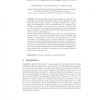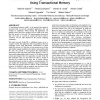71 search results - page 9 / 15 » Two Fundamental Concepts in Skeletal Parallel Programming |
PLDI
2010
ACM
14 years 23 days ago
2010
ACM
Low-level program analysis is a fundamental problem, taking the shape of “flow analysis” in functional languages and “points-to” analysis in imperative and object-oriente...
VL
1998
IEEE
13 years 12 months ago
1998
IEEE
This article presents the animated visual 3D programming language SAM (Solid Agents in Motion) for parallel systems specification and animation. A SAM program is a set of interact...
PADL
2010
Springer
14 years 4 months ago
2010
Springer
Abstract. Skeletons simplify parallel programming by providing general patterns of parallel computations. When several skeletons are used inside the same program, skeleton composit...
ICS
2009
Tsinghua U.
14 years 2 months ago
2009
Tsinghua U.
“Is transactional memory useful?” is the question that cannot be answered until we provide substantial applications that can evaluate its capabilities. While existing TM appli...
OOPSLA
2004
Springer
14 years 1 months ago
2004
Springer
A long-standing goal of software engineering is to construct software that is easily modified and extended. Recent advances in software design techniques, such as aspect-oriented ...


